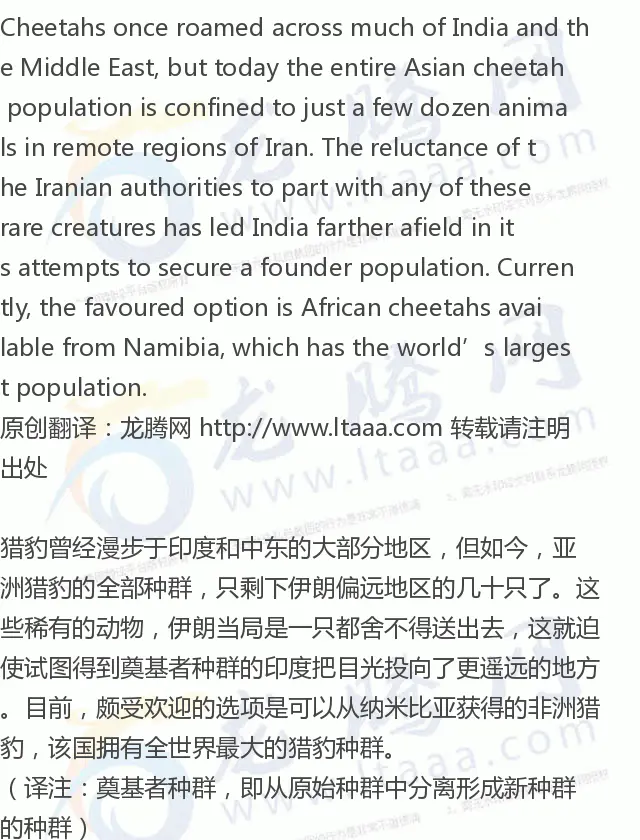【龙腾网】印度重新引进猎豹的计划是否会陷入困境?
正文翻译

December 18, 2020 3.26pm GMT
Simon Evans Principal Lecturer in Ecotourism, Anglia Ruskin University
(作者为英国安格利亚鲁斯金大学生态旅游专业首席讲师西蒙·埃文斯)
A nature reserve in India could soon be the only location in the world to host wild populations of four major big cat species – tiger, lion, leopard and cheetah. Kuno-Palpur, in central state of Madhya Pradesh, may not be one of India’s best-known sanctuaries but it is certainly becoming one of its most controversial. In early 2020, the country’s supreme court agreed that wildlife authorities there could reintroduce the cheetah to India, 70 years after its local extinction.
在印度,有一个自然保护区可能很快就会成为全球唯一一个拥有地位重要的四种大型猫科动物野生种群(虎、狮、花豹和猎豹)的地方。位于中央邦中部的库诺-帕尔普尔可能不是印度最有名的动物保护区之一,但毫无疑问,它正在成为最富争议的保护区之一。2020年初的时候,该国最高法院批准了当地的野生动物管理部门可以将猎豹重新引进到印度,此时,距离猎豹在当地灭绝已经有70年了。

Map of Africa and Asia showing cheetahs former and current range.
The world’s 10,000 or so cheetahs live in a tiny portion of their former range.

(图解:猎豹古今分布范围对比。如今,全世界1万头上下的猎豹,生活的地区只占到昔日分布范围的极小一部分)
Kuno-Palpur was identified as the preferred location for India’s relocation programme as it has large grasslands, ideally suited to the cheetah’s need to build up speed without worrying about trees or other obstacles. These grasslands were formed, in large part, through the removal of villages and rewilding of agricultural land to make way for the relocation of the Asiatic lion.
库诺-巴尔普尔被敲定为印度重新安置计划的首选地点,因为这里有广袤的草原,这就非常理想了,很适合猎豹的需要,因为猎豹在提速时就无须担心树木或其他障碍物的阻挡了。产生这些草原的主因是迁走了村庄以及退耕还草,而这是在给重新安置亚洲狮腾地方。

Asiatic lions are smaller than their African cousins, have smaller and darker manes, and all live in one forest.

(图解:亚洲狮的体型比它们的非洲表亲小,鬃毛更少、颜色也更深,如今的它们全都生活在一片森林里(吉尔保护区))
In 2016 India’s supreme court, citing unacceptable delays, ordered the lion relocation process to be completed within six months. At the same time, the court dismissed a parallel application for the reintroduction of cheetahs, reasoning that it would be paradoxical to elevate the claims of an exotic subspecies (African cheetahs) over those of an endemic (Asiatic lions).
2016年的时候,印度最高法院指控其延误不可接受,令其在6个月内完成狮子的再安置过程。与此同时,法院没有受理一项要求重新引进猎豹的平行申请,给出的理由是:让一个针对外来亚种(非洲猎豹)的诉求凌驾于针对一个特有物种(亚洲狮)的诉求是荒谬的。


(图解:图为印度的花豹)

A cheetah chases after a small antelope.
Springbok hunting in Namibia. Elana Erasmus / shutterstock

(图解:纳米比亚,一只猎豹正在追赶一只小羚羊)
There is also credible evidence that tigers are already dispersing to Kuno-Palpur as animals from a reserve in neighbouring Rajasthan seek to escape territorial over-crowding. This suggests there is a functioning wildlife corridor between the two reserves, a stated priority for Indian conservation.
还有可靠的证据表明,老虎已经散布到了库诺-巴尔普尔地区,因为在与之相邻的拉贾斯坦邦,有一个保护区内的动物正在设法逃离过于拥挤的地盘。这就表明在两个保护区之间存在一条能起到作用的野生动物走廊,而这恰是印度动保工作既定的优先事项。

(图解:拉贾斯坦邦的孟加拉虎)
This is not a simple issue to resolve. As the supreme court is increasingly called upon to adjudicate between the various factions, so these conundrums are likely to intensify in the future. There is no science available currently to suggest that cheetahs, lions, tigers and leopards can coexist comfortably in the same habitat. It has never occurred anywhere else before, so there is no real-life experience to draw upon.
这不是一个容易解决的问题。由于要求最高法院在各派系之间居中裁决的情况越来越多,因此在未来,这些难题很可能会加剧。目前找不到任何科学证据能证明猎豹、狮、虎和花豹可以在同一个栖息地内和谐共存。这种情况,以前在其他任何地方都没有发生过,所以没有现实中的经验可供借鉴。
In my research for a forthcoming book on tigers I found India’s wildlife is becoming increasingly commercialised and much of what we accept as rational conservation can just as easily be viewed through an economic lens – one that reflects the benefits of tourism. On the surface, the cheetah scheme feels more like a vanity project than a conservation imperative; no doubt a boon for wildlife tourism but maybe also presenting a threat of intra-species and human-wildlife conflict.
在我为即将问世的一本有关老虎的书进行的研究中,我发现印度的野生动物被商品化的程度正变得越来越高,而为我们所接受的理性保护中的很多方面,同样可以很容易地放在经济角度中去看待,这个角度体现的是旅游业的利益。表面上看,这个猎豹计划更像是一个满足虚荣心的项目,并不是施行保护的必由之路;这对野生动物旅游来说,是一大利好,但也许,也会带来物种内部和人与野生动物之间的冲突。
评论翻译


